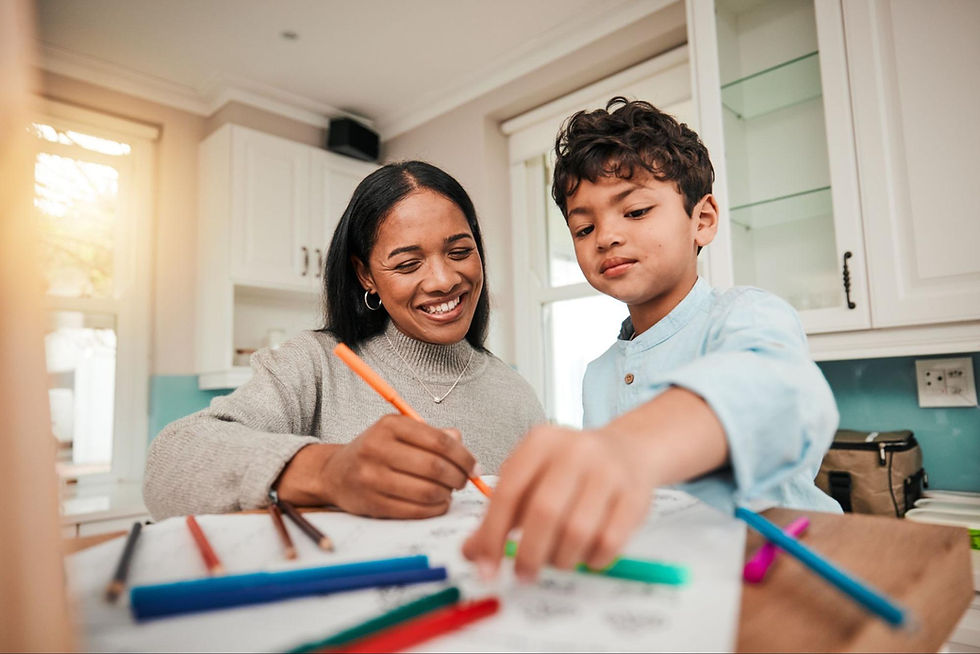How to Become Fluent in Spanish Fast
- Homeschool Languages

- Nov 17
- 7 min read
To become fluent in Spanish, practice daily through conversation, songs, and immersion. Focus on high-frequency phrases, listening, and real-life use, not memorization. Small, consistent actions help you think, respond, and live naturally in Spanish faster than traditional study.
Quick Peek: What You’ll Find Here
What fluency in Spanish really means (and why perfection isn’t the goal)
How the 80/20 rule helps you learn smarter, not harder
A simple step-by-step plan for real-life fluency
The biggest roadblocks that slow learners down, and how to beat them
The open-and-go method that helps families speak Spanish at home
At Homeschool Languages, we built open-and-go Spanish kits that show families how to start speaking naturally, no prep, no guesswork. Every lesson is designed to get kids (and parents!) using real Spanish right away through songs, games, and everyday routines.
If you’re just looking for another list of apps or grammar tricks, this probably isn’t it. But if you want to live Spanish at home, and learn how small daily moments lead to fluency, keep reading.
We’ll show you how to make it happen step by step!!
What Fluency in Spanish Really Means
“Fluent” doesn’t mean perfect. It means comfortable. It means being able to chat with your child in Spanish while making breakfast or thank a waiter on vacation without reaching for Google Translate.
The truth is, there are different kinds of fluency:
Conversational fluency: holding everyday talks with ease
Cultural fluency: understanding humor, music, and traditions
Family fluency: bringing Spanish into your home life naturally
Fluency isn’t about having flawless grammar, it’s about building confidence through connection. You don’t need to move abroad or spend hours buried in books. What you need is consistency, conversation, and a method that fits your lifestyle.
Choose your focus language style early. If you’re learning Spanish as a family, stick with Latin American Spanish, it’s friendlier, easier for kids to pronounce, and aligns with most homeschool curriculums (including ours!).
The 80/20 Rule of Spanish Learning

Here’s a secret that changes everything: 20% of your effort creates 80% of your results!
You don’t need ten different apps or a notebook full of verb charts. Fluency comes from the small, consistent things, listening, speaking, and playing with Spanish every day.
That’s why we tell families to stop “studying” Spanish and start using it. Instead of memorizing vocabulary, focus on real-life moments. Ask, “Quieres agua?” instead of “Do you want water?” or sing a “thank you” song before dinner. These micro-moments are the heartbeat of fluency.
Too many parents overload their kids with materials, hoping more will mean better results. In reality, the opposite happens, kids shut down. One resource, one rhythm, one routine will take you further than juggling five.
Homeschool Languages’ step-by-step kits follow this rule perfectly: you open the box, start one short lesson, and let Spanish flow through your day, no overwhelm, no confusion.
Step-by-Step Plan to Become Fluent in Spanish
Fluency doesn’t come from doing “more.” It comes from building habits that stick. Here’s how to do it, right where you are.
Step 1 , Immerse Yourself (Where You Are)
Immersion isn’t about location; it’s about lifestyle. You don’t have to move to Spain, you can bring Spain (or Mexico!) into your home.
Switch music, cartoons, and podcasts to Spanish.
Make a “Spanish corner” with bilingual books, flashcards, or your Homeschool Languages kit.
Try family Spanish-only mornings once a week: greetings, breakfast, and chores in Spanish.
Immersion is simply surrounding your family with Spanish so your brain starts treating it like “normal.”
It’s powerful, and yes, it works even in the middle of Wyoming!!!!
Step 2: Practice Speaking Early and Often
Here’s what most learners miss: you can’t get fluent by only listening. You have to speak, even when it’s messy.
Start small:
Repeat phrases aloud after songs.
Narrate your day in simple Spanish (“Let’s wash hands, lavamos las manos”).
Use a puppet or character who “doesn’t understand English” to get kids responding in Spanish.
Parents often worry, “What if I mispronounce?” Don’t. Fluency grows through imperfect practice. Your kids will remember confidence before they remember correctness. And that’s what keeps them speaking.
Step 3: Build Vocabulary That Matters
Forget random word lists. You’ll remember words faster when they’re connected to real life. Focus on what you actually say in your home every day.
Start with high-frequency words like quiero, dame, gracias, por favor.
Label your environment: la puerta (door), la mesa (table), la silla (chair).
Read together! Children’s stories, short bilingual books, or Homeschool Languages story units are perfect for building memory through repetition and context.
When you use words in sentences instead of isolation, they stick. Say, “Quiero leche, por favor” every morning and you’ll never forget it. Vocabulary doesn’t live on flashcards, it lives in your kitchen, your bedtime routine, and your family conversations.
Step 4: Listen More Than You Speak (At First)
Before kids speak fluently, they listen fluently. The same goes for you. Listening tunes your ear to Spanish rhythm, helping you understand before you try to reply.
Try this:
Play Spanish music during breakfast or car rides.
Listen to short Spanish podcasts while folding laundry.
Watch Spanish cartoons with Spanish subtitles to connect sound and meaning.
You don’t need to understand every word. Your brain learns patterns through sound long before translation. Over time, you’ll recognize phrases naturally, and that’s when speaking becomes effortless.
Homeschool Languages lessons use songs and repetition for exactly this reason: kids (and parents) start hearing before speaking. That’s what builds real fluency.
Step 5: Celebrate Small Wins
Fluency is a collection of little victories.
The first time your child answers “Sí.”
The moment you both sing a song without looking at the lyrics.
The time you order food in Spanish and everyone smiles.
Each of those moments matters. They’re proof that your family’s bilingual journey is working.
Keep it fun and visible, add stickers, stars, or a “Spanish Wins” chart on the fridge. Kids thrive on progress they can see. And when they feel proud, they keep going.
Remember, this isn’t about perfect pronunciation. It’s about joy, connection, and consistency. Every word spoken counts!!!
Common Roadblocks and How to Beat Them

Even the most motivated families hit bumps along the way. Here’s how to smooth them out:
“I’m not fluent, how can I teach?” You don’t have to be! That’s why we created scripted lessons with pronunciation support. When your child sees you learning too, it models courage and curiosity.
“My kids understand but don’t speak back.” Totally normal. Kids need safety to speak. Puppets, songs, and silly challenges lower pressure and make Spanish feel like playtime, not homework.
“We don’t have time.” You don’t need hours. Five to ten focused minutes a day, during snack time, chores, or bedtime, is more than enough.
“We mix up dialects.” Pick one (Latin American or Castilian) and stick to it for at least six months. Consistency builds clarity, and kids adapt faster than adults anyway!
These worries aren’t roadblocks, they’re milestones. Each one means you’re in motion, learning, and growing as a bilingual family.
Immersion Doesn’t Mean Moving Abroad
Immersion isn’t geography, it’s mindset. You can live in the U.S. and still create a full Spanish experience at home.
Here’s how to do it:
Switch your family playlist to Spanish.
Watch Spanish TV or YouTube shows together.
Try “Spanish Saturdays”, a half-day where you speak only Spanish around the house.
Use Homeschool Languages kits to guide conversations and daily routines.
When Spanish becomes the background sound of your life, fluency follows naturally. You’ll be surprised how quickly kids (and you!) start replying without hesitation.
How Long Does It Take to Become Fluent in Spanish?

The Foreign Service Institute estimates 600 hours for fluency, but that’s classroom time, not family life. You’ll move faster by weaving Spanish into your day!
Here’s what’s realistic at home:
3 months: understanding songs and basic commands
6 months: short daily conversations in Spanish
12 months: confident bilingual play and family talk
Progress depends on frequency, not length. Ten minutes every day beats two hours on the weekend. And when Spanish feels natural, not forced, you’ll see results that last.
Tools and Resources That Actually Help
Here’s what’s worth your time:
Homeschool Languages: Open-and-go kits that get kids responding naturally.
Free practice: Spanish radio, podcasts, and YouTube shows.
Apps for support: Duolingo (vocab), Italki (conversation), Lingopie (listening).
Printable resources: flashcards, labeling sheets, and bilingual story sets.
Tip: Don’t stack five tools at once. Pick one and stay consistent for at least six weeks before trying another. You’ll build rhythm and confidence instead of confusion.
The Family Approach to Fluency

When we first started teaching our kids Spanish, we felt completely stuck. We spoke some Spanish ourselves, but not fluently at home. Our kids tuned out whenever we switched languages, and no workbook or app could bridge that gap.
So, we built Homeschool Languages to fill it. Our open-and-go Spanish curriculum helps families go from “I want to teach Spanish” to “We actually speak Spanish together.”
We use real conversations, playful activities, and songs that lead kids toward one goal, responding back in Spanish.
That’s the magic moment where fluency starts!!!
We believe Spanish learning shouldn’t feel like another subject. It should feel like part of family life, full of laughter, connection, and those sweet “Did you hear that? He just said it in Spanish!” moments that make it all worth it.
Live Your Spanish Story
Fluency isn’t about checking boxes or hitting a word count. It’s about connection, the kind that happens at the dinner table, during bedtime stories, or while singing Buenos días together.
You don’t need to live abroad or be fluent already. You just need a way to bring Spanish into the life you already love.
Start small. Speak daily. Celebrate every win.
And when you’re ready for guided support, we’d love to help you build your bilingual home with Homeschool Languages’ Spanish curriculum, where every lesson moves your family from “learning words” to living Spanish.
Because fluency isn’t found in a textbook. It’s built one joyful moment at a time!




Comments